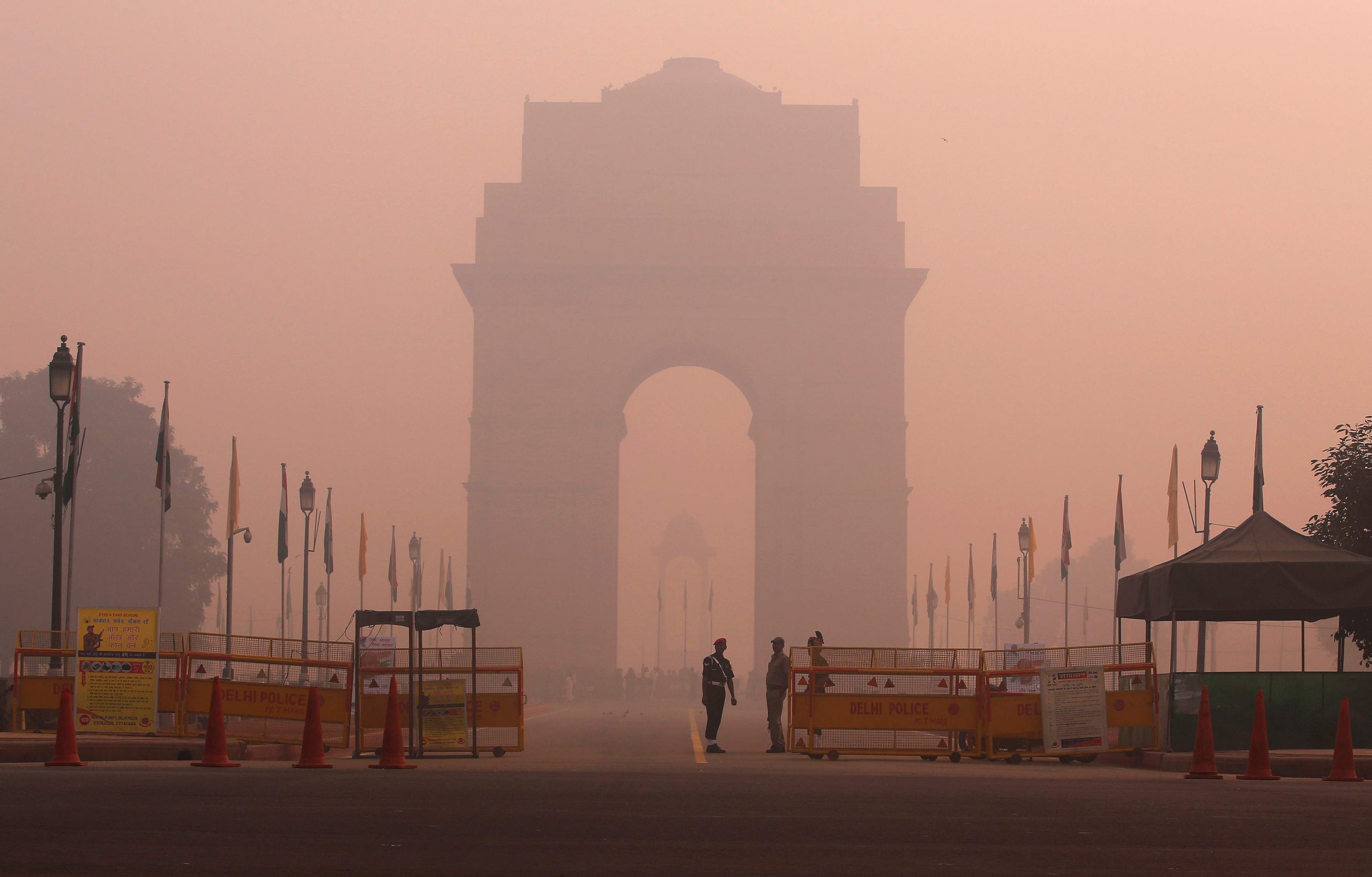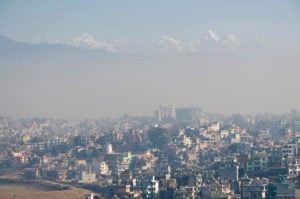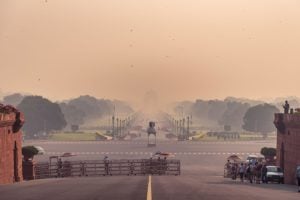The sister cities of Lahore, in Pakistan, and New Delhi, in India, share many things – food, culture, and now a pall of air pollution that hangs over the cities through much of the winter months. While New Delhi has consistently ranked as one of the most polluted cities in the world, in recent years Lahore has swiftly climbed up those rankings – sometimes overtaking New Delhi.
In both cities, the brunt of the problem falls hardest on children. In New Delhi, schools were ordered to shut in November 2022 as air pollution reached “hazardous” levels. In December, schools in Lahore followed suit, extending the winter vacation in an effort to keep children – whose lungs are still developing – safe.
For Imrah and Sarah Sarfaraz, two sisters aged 15 and 17 who study at Lahore’s Jesus and Mary Convent school, the school closure offered some relief. Wearing a face mask – now to protect against air pollution rather than Covid-19 – Imrah told The Third Pole: “I had flu while my elder sister developed skin allergies. We also face problems breathing due to the smog. It hurts in the throat.” It is even harder for two of her friends, who already suffer from asthma.
Big issues left untouched in response to air pollution in Lahore
Closing down schools is only one of the measures that authorities have taken in the two cities. Ever since the Lahore High Court ordered the Pakistan government to implement its own laws on climate change issues in 2015, there has been persistent judicial pressure to address the problem. The High Court judges meet every Friday throughout the year to discuss implementation of actions to deal with issues like air pollution.
Khawaja Muhammad Sikandar Zeeshan, director general of Pakistan’s Punjab Environment Protection Agency, told The Third Pole that this year, “For the first time, we have set up a sophisticated data collection centre, which is tasked with identifying the sources causing smog, responding to public complaints, generating reports on a daily basis and then acting upon them.”
He added that 6,457 cases were lodged against individuals or industrial units for burning waste in Lahore alone. His department has also launched five special ‘Anti-Smog Squads’, which conduct regular field visits and take on-the-spot legal action against violators of the ban on burning waste.
“These squads have imposed fines worth PKR 4.5 million [USD 19,800] against the polluting factories, the smoke-emitting vehicles, farmers burning the stubble and garbage since October,” he said, adding that fines had doubled compared to the previous year.
For environmentalist and lawyer Ahmad Rafay Alam, much of this is too little and too late. “Every year we shut the brick kiln, the small industries and simply identify the hotspot for smog. Just setting up a data centre will not make difference,” he said.
In Pakistan, a major cause of air pollution is the use of substandard petrol, diesel and furnace oil in vehicles, industry and refineries. Vehicle emissions standards for Pakistani vehicles are still at ‘Euro 2’ levels, which allow more carbon dioxide, particulate matter and other emissions compared to the Euro 6 standards that India is moving to enforcing. “These are the elites,” Alam told The Third Pole, referring to vehicle owners and those using furnace oil and coal for power plants. “No action has been taken against the refineries using the furnace oil. Have you heard of coal fired plant being acted against?”
Big plans, big money, but little improvement in New Delhi
Across the border, in New Delhi, while vehicle emissions may be set to a higher standard, the air is just as polluted, despite a National Clean Air Programme (NCAP) launched by the Indian government in 2019. This plan initially set a target of reducing key air pollutants PM 10 and PM 2.5 (particulate matter that is 2.5 microns or less in diameter and able to enter directly into the bloodstream) by 20-30% across 122 Indian cities by 2024, using pollution levels in 2017 as the baseline. In September 2022, this target was revised to a 40% reduction in particulate matter concentration by 2026.
But after four years, and an expenditure of INR 6.9 billion (USD 83 million), experts say progress on tackling New Delhi’s air pollution has been slow. “Data shows there is marginal improvement in Delhi’s air quality over the last three years,” said Aarti Khosla, director of Climate Trends, which runs the NCAP Tracker – an online resource that tracks the implementation of the programme – in collaboration with tech startup Respirer Living Sciences.
Gains that other countries have made on controlling air pollution were through science-based policy, highest level political commitment and tough penalties for non-complianceAarti Khosla, Climate Trends
The Indian environment ministry’s tracker of air pollution in New Delhi does not mention PM 2.5, only levels of the less dangerous PM 10 – and this shows a decline of barely 10%.
“For a city with enormous density and ever-increasing [population], only radical policy changes can bring some benefits to the air quality. We’ve seen that any gains that other countries have made on controlling air pollution were through science-based policy making, highest level political commitment and collaboration, and tough penalties for non-compliance. The model will have to be similar if we need to rapidly clean the Delhi skies,” said Khosla.
Gufran Beig, founder of the System of Air Quality and Weather Forecasting and Research (SAFAR) – the Ministry of Earth Science’s air quality monitoring system – said that vehicular emissions are the biggest cause of air pollution in New Delhi. “The transport sector contributed to about 38% to 40% [to air pollution] in 2020,” Beig told The Third Pole. And when it comes to emissions from vehicles, the trend is going in the wrong direction.
“In the last decade, the transport sector in Delhi has grown by 40%, whereas biofuel emissions, which are mainly the residential emissions, have gone down by 46%. But the magnitude of the transport sector is so high that this 46% doesn’t make much of a difference. Overall, in the last decade, the increase in emission is around 12% to 15%. This [vehicle emissions] is the primary source of pollution,” said Beig.
Stubble burning gets due, and undue attention
It is stubble burning – a cheap way to clear fields of farm residue before the planting of the next season’s crops – that dominates much of the discussion on air pollution.
“During winter, about 20 to 25% [of pollutants in Delhi] are transboundary pollutants,” added Beig. “One major source of pollution is stubble burning. It comes from the northwest region towards Delhi, which adds to the deteriorating air quality during October and November.”
LS Kurinji, programme associate at the Council on Energy, Environment and Water (CEEW), a New Delhi-based think tank, told The Third Pole: “Stubble burning is a seasonal contributor to air pollution. Its contribution to Delhi or Punjab’s air quality is within a span of 15 to 20 days, typically between late October and mid-November, during harvest time.” Since this coincides with meteorological changes – a shift in wind direction and lower temperatures, this increases the severity of air pollution during this time period.

The geographical specificity of where the burning happens means that a specific set of people can be blamed. According to a CEEW report from November 2022, “the Malwa region of [Indian] Punjab has the highest number of post-Kharif [autumn crop] farm fires in the state. Currently, it accounts for over 80% of the 40,000+ farm fires detected in 2022.” The upside of this is that change can happen quickly. A study conducted by CEEW found that the Indian state has seen a “dramatic increase in the deployment of in-situ crop residue management,” meaning the stubble is managed without burning.
According to Karunesh Garg, the chief environmental engineer of the Indian Punjab pollution control board, 30% fewer fire incidents were reported from Punjab in 2022 than in the previous year. He also emphasised, “Stubble burning in Punjab contributes only 5% to 10% to the air pollution in Delhi. The rest of the pollution is generated in Delhi itself.”
Cross-border blame game
The visibility of the stubble fires in India in satellite imagery has led some Pakistani politicians to claim that Indian crop burning is mostly responsible for Lahore’s air pollution woes.
When asked if the Pakistani authorities had ever taken the matter up with the Indian government, Zeeshan of the Pakistani Punjab environment department said that “it was a matter concerning the Foreign Office. And I’m sure, they would have taken the matter up with the Indian Foreign Office.”
TCA Raghavan, who served as Indian High Commissioner to Pakistan between 2013 and 2015, told The Third Pole: “There may have been allegations and counter-allegations regarding cross border air pollution, but at least to my knowledge, there has been no discussion, at a governmental level, on this issue between the two countries. Even between experts at the non-governmental level in India and Pakistan, there has not been any major discussion.”
The Third Pole approached Pakistan’s climate change minister Sherry Rehman, but she was unavailable to comment on the matter, and the Pakistan Foreign Affairs Ministry did not respond to queries. However, a Pakistani diplomat who had served in India, speaking on condition of anonymity, said that bilateral ties between the two countries had been strained since the Indian government had repealed Article 370 in the Indian-managed part of Kashmir in August 2019. “Ever since, there is rarely any issue discussed between Pakistan and India. As far as the issue of stubble burning is concerned, it would have hardly been taken up, being a minor issue.”
But Siddharth Singh, author of ‘The Great Smog of India’, emphasised that tackling air pollution in India and Pakistan will require transboundary cooperation. “Air knows no political borders. It is an issue that needs to be analysed in terms of the entire airshed of a particular geography. The eastern parts of Pakistan, especially in the Punjab region, and the western and central Gangetic plains are all a part of the same airshed. You cannot possibly clean one part of the airshed without cleaning the others,” he told The Third Pole.
“In fact, this [airshed within which pollutants are trapped during winter] stretches all the way to Bangladesh,” he added. “If you need to clean the air in this region, you basically need a version of the Paris Agreement, but for air pollution, which does not have to be global. But, at least, in this case, [it must] bring together these three countries, so that the local sources of air pollutants in each country are identified and acted against.”









